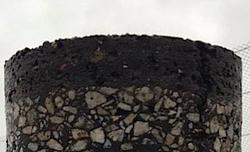108-year-old core sample from Indianapolis Motor Speedway track, including the original bricks from 1909.
Previously:
Drag racer switches motorcycles mid-race
Slow motion dragster GIF
steam locomotive drag racing
NHRA Funny Car engine explosion



108-year-old core sample from Indianapolis Motor Speedway track, including the original bricks from 1909.
Previously:
Drag racer switches motorcycles mid-race
Slow motion dragster GIF
steam locomotive drag racing
NHRA Funny Car engine explosion

New plans added on 01/03/2025: Click here for 2,682 plans for homemade tools.
Cascao (Oct 30, 2017), gunsgt1863 (Oct 30, 2017), Seedtick (Oct 28, 2017)

Notice the crack in the top layer of the core sample.Core samples of craks are often taken to determine the origins or reasons for cracking this allows engineers to analyze a solution to prevent them from occurring again . I can see where a deep under laying crack dating all the way back to the brick would have been the culprit, what would have been even better would be if the core sample had included the first attempt at creating the road way surface which was gravel oil and a tar like substance, plus a couple more feet of strata below that. Then another core sample from an area where no visible cracking could be located using an ultra sounding seismic device would show where compaction may not have been completely even. The over 3 million bricks were not added until late in 1909 the first actual 500 mile race wasn't until 1911
Never try to tell me it can't be done
When I have to paint I use KBS products
Jon (Oct 29, 2017)

In the topmost, newest layer, there are no visible embedded rocks. Why? Safety issue? Technological advancement in paving? Are all of the layers in between the topmost layer and the lower bricks identical?
New plans added on 01/03/2025: Click here for 2,682 plans for homemade tools.

Jon looking at a close up view of the top layer it would appear the formulation of the surfacing material has indeed undergone technical upgrading. That plus you can see smaller bits of aggregate mostly discolored indicating the possibility of recycled materials were involved as well. I also detect several small voids in the layer which means to me either high or low heat at time of application that plus possibly not enough compaction rolling. If the heat was too high the voids could have been formed by out gassing if the heat was too low I would suspect trapped air pockets due to not being rolled enough times.
In any case these voids can lead to moisture permeating down into the layer which would freeze in winter, and we all know what that can lead to

Never try to tell me it can't be done
When I have to paint I use KBS products

Ralph the Indianapolis speedway got the name the brick yard because it was paved with 3.2 million 10 lb bricks after it was first constructed. the Idea and inital construction dates back to 1906 the first races were ran in I think June of 1909 it wasn't until 1911 when the first 500 mile race was ran it wa won by a Marmon car the predecessor to the Marmon trucks I don't know when it was finally paved over with asphalt.
but yes all of the layers shown in the picture are on top of the bricks
Never try to tell me it can't be done
When I have to paint I use KBS products

It looks like this core sample was taken two days ago, on October 27th. Here's the original tweet about it:
https://twitter.com/jdouglas4/status/923938575388995584
The sourcing is pretty good here. The Twitter account, jdouglas4, is J. Douglas Boles, the president of Indianapolis Motor Speedway.
New plans added on 01/03/2025: Click here for 2,682 plans for homemade tools.
There are currently 1 users browsing this thread. (0 members and 1 guests)
Bookmarks